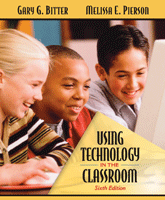Using Technology in the Classroom
By Murray Bourne, 25 Sep 2005

by Bitter, GG and Pierson, M (©2005, Pearson Education)
Summary Review
Using Technology in the Classroom has been around for a while (first edition 1984, revised every 5 years or so).
The book appears to be aimed at an undergraduate teacher-trainee level, with advice on how to select software & Internet resources and how to use them in classrooms that often have limited technology resources.
The earlier chapters address the issues of student, teacher and administrator technology standards, especially the ISTE National Educational Technology Standards for teachers and students. Such standards are a good place to start - if you don't know where you are going, you'll never get there.
Chapter 5 focuses on research into the effectiveness of technology for learning. It tends to suffer a bit from research obsolescence in places. Things are moving so quickly that you need to be careful citing 10 year-old research findings. The move away from Computer Aided Learning (drill and kill) to collaborative, Web-based constructivist learning has been significant in the last 10 years.
The accompanying DVD is surprisingly poor in parts. In one of the classrooms presented, I felt sorry for the bored, sleepy students who have little interest or ownership in the computer activity (the teacher is just showing the kids what to do.) In another, the disorganised teacher is getting kids to "prove" some algebraic construct. There is a lot more potential than this!
The book has some excellent resources and some of the discussion is thought provoking. I would suggest that they rewrite from scratch next time, however...
Be the first to comment below.